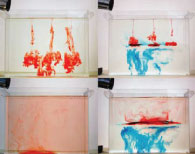 |
NASA | GSFC | JPL | Site Map |
|
|
 |
 |
Education: Student Outcomes |
Click here to search for other assets Effect of Stratification on Mixing Grade level: 9-12 Theme: water cycle Activity: http://www.tos.org/hands-on/teaching_phys_concepts.pdf
Mixing of stratified layers requires work. Without energetic mixing (e.g., due to wind or breaking waves), the exchanges of gases and nutrients between surface and deep layers will occur by molecular diffusion and local stirring by organisms, which are slow, ineffective modes of transfer. The energy needed for mixing is, at a minimum, the difference in potential energy between the mixed and stratified fluids. Therefore, the more stratified the water column, the higher the energy needed for vertical mixing. Density is fundamentally important to large-scale ocean circulation. An increase in the density of surface water, through a decrease in temperature (cooling) or an increase in salinity (ice formation and evaporation), results in gravitational instability (i.e., dense water overlying less-dense water) and sinking of surface waters to depth. Once a sinking water mass reaches a depth at which its density matches the ambient density, the mass flows horizontally, along "surfaces" of equal density. This process of dense-water formation and subsequent sinking is the driver of thermohaline circulation in the ocean. It is observed in low latitudes (e.g., the Gulf of Aqaba in the Red Sea, the Gulf of Lions in the Mediterranean Sea) as well as in high latitudes (e.g., deep water formation in the North Atlantic). This experiment looks at the energy required to mix two layers. Students should read the Background section (p. 4-5) of Chapter 1 (Density) in preparation for this activity. Videos
Flash Video | QuickTime MovieStudent Outcomes After completing this activity, students should be able to: Explain the relationship between fresh water and ocean dynamics. (W: 9-12) Key: C = climate / O = ocean circulation / T = 21st century technology / W = water cycle |
|||||
